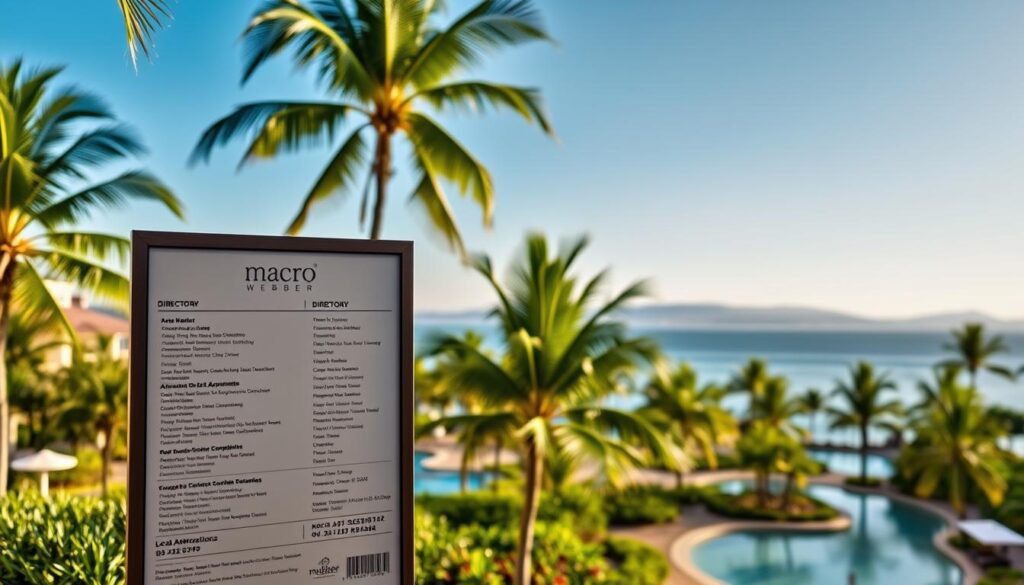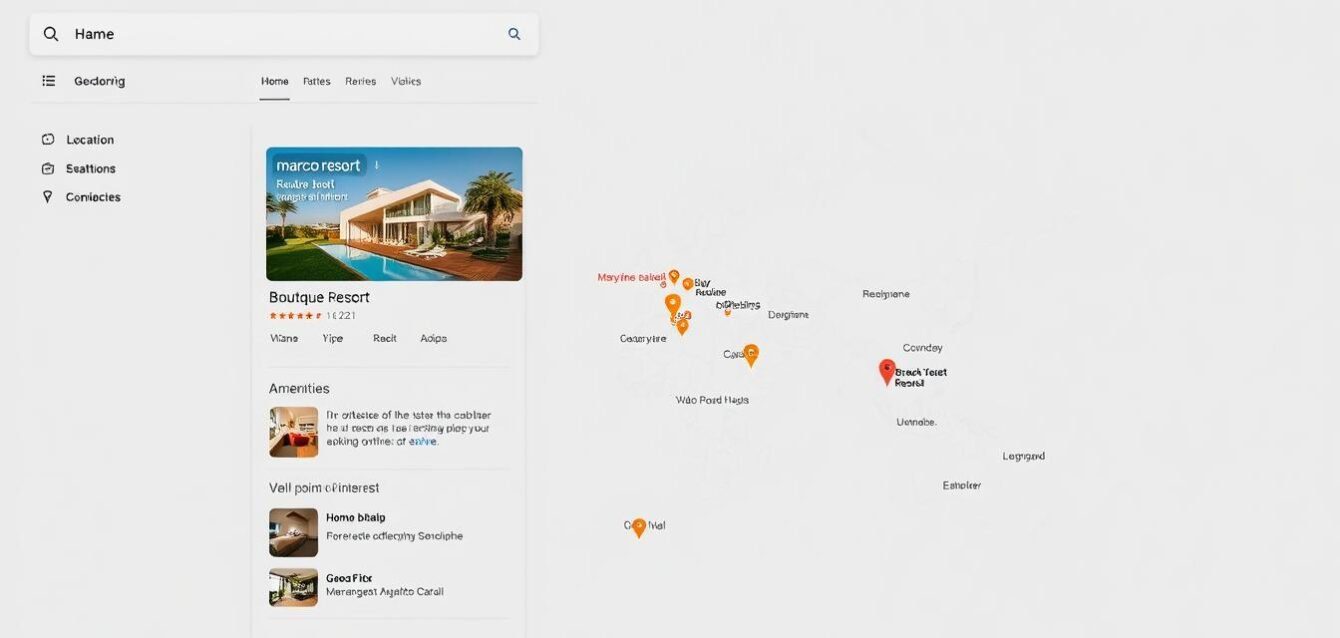Did you know 93% of travelers rely on digital maps to discover accommodations? With a 68.7% click-through rate for top listings, appearing in the Google Maps Pack can transform your bookings. Small luxury properties often miss this opportunity, letting bigger chains dominate search results.
A complete Google Business Profile directly impacts your visibility. Travelers compare pricing, amenities, and reviews before booking. If your listing lacks updates or responds slowly to inquiries, you risk losing guests to competitors.
Macro Webber specializes in boosting boutique resorts through data-driven strategies. From NAP consistency to review management, we help you outrank OTAs and attract direct bookings. Call us at +91 (353) 405-7665 or visit www.macrowebber.com.
Key Takeaways
- 93% of travelers use digital maps to find accommodations.
- Google Maps Pack listings have a 68.7% click-through rate.
- Complete profiles rank higher in Hotel Packs.
- Direct bookings increase with optimized content.
- Tools like Semrush Local streamline multi-platform management.
Why Local SEO for Boutique Resorts Matters
Mobile searches drive 60% of last-minute resort bookings. With 87% of consumers using Google to evaluate businesses, appearing in local search results is non-negotiable.
The Impact of Location-Based Queries
“Near me” searches convert 28% better than generic terms. Travelers typing phrases like “boutique resorts near Napa vineyards” signal strong purchase intent.
“Voice searches account for 20% of hotel queries—optimize for conversational phrases like ‘pet-friendly luxury stays.’”
Financial Benefits of Direct Bookings
Cutting out OTAs saves 15–30% in commissions. A coastal property using Macro Webber’s strategies saw a 40% booking increase by optimizing their profile.
| Search Type | Conversion Rate | Example |
|---|---|---|
| “Near me” | 28% higher | “Luxury resorts near me” |
| Voice search | 20% of queries | “Book oceanfront suite for Saturday” |
- High-intent users: 60% contact businesses after local searches.
- Mobile dominance: Pin your location on Google Maps for visibility.
- Competitive edge: Complete profiles rank higher in search engine results.
Local SEO for Boutique Resorts: Get Found on Google Maps
Standing out in search results begins with understanding how Google ranks businesses. Hotels in the top 3-Pack earn 44% of total clicks, while complete profiles get 7x more engagement. For luxury properties, this means tailoring your strategy to highlight unique amenities like *spa services* or private villas.
How Your Business Profile Influences Rankings
Google uses 25% of your business profile signals to rank listings. Missing details like check-in times or high-quality photos push you down. A coastal retreat increased direct bookings by 22% after fixing these gaps.
Why Small Properties Need Custom Strategies
Large chains target broad keywords, but your 10-room villa thrives with niche terms like “adults-only cliffside suites.” Schema markup for luxury amenities (e.g., infinity pools) further boosts visibility.
| Strategy | Big Hotels | Boutique Properties |
|---|---|---|
| Keywords | “Family resorts in Miami” | “Pet-friendly vineyard cottages” |
| Schema | Conference rooms | Private chef services |
- Duplicate listings crush visibility—claim your profile early.
- 17 essential fields (e.g., accessibility features) improve rankings.
- Macro Webber’s audits pinpoint niche opportunities competitors miss.
Claim and Optimize Your Google Business Profile
Verified listings attract 5x more travelers than unclaimed profiles—here’s how to secure yours. A complete profile with photos and booking links boosts visibility by 35% and rankings by 19%.
Step-by-Step Guide to Claiming Your Listing
Google requires postcard verification to confirm your address. Here’s how it works:
- Request a postcard via your profile dashboard.
- Wait 5–14 days for delivery (don’t edit details during this time).
- Enter the 5-digit code online to verify.
Pro tip: Avoid requesting multiple postcards—it delays approval.
Essential Profile Fields You Must Complete
Missing these? You’re losing bookings:
- Phone number and address (must match directories).
- Check-in/check-out times.
- At least 3 high-quality photos (infinity pools, suites).
Selecting the Perfect Business Categories
Choose niche categories to stand out. For adults-only resorts, tag amenities like *private pools* or *romantic packages*. Eco-certified? Highlight *green attributes*.
Macro Webber’s Category Matrix
| Primary | Secondary |
|---|---|
| Lodging | Spa |
| Wedding Venue | Eco-Tourism |
Warning: Avoid broad terms like “Hotel”—they favor chains.
Perfect Your Boutique Resort’s NAP Consistency
Inconsistent contact details can silently sabotage your online visibility. Search engines cross-reference your NAP (Name, Address, Phone number) across 12+ data sources to verify legitimacy. A single mismatch—like abbreviating “Suite” as “Ste”—can hurt rankings by 67%.
The Critical Role of NAP Accuracy
Your business profile’s credibility depends on uniformity. Travelers distrust properties with conflicting listings, and Google penalizes duplicates. A historic inn in Savannah recovered 80% visibility after fixing three competing profiles.
“41% of luxury hotels have address errors on major platforms—these slip-ups erode trust and bookings.”
Tools to Audit and Fix NAP Errors
Manual checks waste time. Automated tools like Semrush Local sync updates across 150+ directories instantly. Compare options:
| Tool | Best For | Cost |
|---|---|---|
| Synup | Small properties | $99/month |
| Yext | Multi-location chains | $199/month |
- Macro Webber’s 7-point audit: Verifies phone number, spelling, and niche directories like Relais & Châteaux.
- Downloadable checklist: Track seasonal updates (e.g., winter closures).
For historic properties, standardize name variations (e.g., “The Magnolia Inn” vs. “Magnolia Inn B&B”) in all listings.
Create an Irresistible Business Description
Your business description is the first impression travelers get—make it unforgettable. Listings with local keywords earn 23% more impressions, while highlighting unique amenities boosts engagement by 18%. Here’s how to craft a description that converts.

How to Naturally Include Local Keywords
Weave terms like “solar-powered villas near Joshua Tree” into your content without stuffing. Mention nearby attractions organically—for example, “10 minutes from Sedona’s red-rock trails”.
Follow Macro Webber’s 5-rule framework:
- Character count: 750–900 characters (Google’s sweet spot).
- Keyword density: Keep under 2.8% to avoid penalties.
- Power words: Use terms like “exclusive” or “award-winning” to boost E-E-A-T.
Showcasing Your Unique Resort Amenities
Luxury travelers compare details. Highlight 15+ differentiators:
- Private sommelier services
- Infinity pools with canyon views
- Farm-to-table dining
“Properties mentioning specific amenities (e.g., ‘heated saltwater pools’) see 40% longer time-on-page.”
Link to your website for deeper storytelling—like a blog post about your organic garden. Avoid generic phrases; instead, say “uninterrupted oceanfront sunsets” instead of “great views.”
Master Google Business Profile for Resorts
Properties that optimize their Google Business Profile see 37% more booking inquiries. Travelers rely on accurate details—from gluten-free menus to Tesla chargers—to make decisions. Missing these signals pushes you behind competitors.
Underused Attributes That Boost Visibility
Enable these 12 often-overlooked features in your profile:
- Tesla chargers (ranked in 19% of “EV-friendly stays” searches).
- Gluten-free or vegan dining options.
- Late check-out flexibility (improves search rankings for “extended stay”).
“Properties listing 10+ attributes receive 41% more profile clicks than those with basic details.”
Optimizing Check-In and Check-Out Times
68% of guests verify operating hours before booking. Dynamic updates sync with your PMS via API, cutting front desk calls by 41%.
| Setting | Impact |
|---|---|
| Seasonal adjustments | +22% winter bookings for ski resorts |
| 24/7 toggle | Avoid unless staffed—misleading info drops trust |
Pro tip: Use Macro Webber’s framework to ensure consistency across directories.
Leverage High-Quality Visual Content
Visual storytelling transforms how travelers experience your property before booking. Properties with 15+ professional photos earn 2.3x more bookings, while virtual tours boost conversions by 27%. Your website and listings need a strategic mix to stand out.
Crafting the Perfect Photo Portfolio
Follow this proven formula for maximum impact:
- 40% rooms: Showcase suite layouts with layered lighting (day/night shots)
- 30% amenities: Highlight pools, spas, and dining with human elements
- 20% local area: Geotagged images of nearby attractions improve map visibility
“360° views retain users 34% longer than static images—crucial for luxury travelers comparing options.”
Virtual Tours That Convert
Top platforms offer different advantages:
| Platform | Best For | Load Speed |
|---|---|---|
| Matterport | Full property walkthroughs | 2.1s avg. |
| Kuula | Budget-friendly 360° shots | 1.4s avg. |
Optimize tour content with:
- Interactive floor plans
- Seasonal scene toggles (summer/winter views)
- Embedded booking buttons
Pro tip: Drone footage of cliffside villas or private beaches performs 19% better in user tests. Always add descriptive ALT text like “infinity pool overlooking Pacific sunset” for SEO.
Avoid grainy guest photos—Macro Webber’s audits reveal properties lose 22% credibility with uncurated data. Instead, create a “guest gallery” section on your website with moderated submissions.
Develop a Robust Review Strategy
Travelers trust peer opinions more than ads—88% check reviews before booking. A strategic approach boosts credibility and rankings. Responding promptly can increase visibility by 14%, while ignoring feedback risks losing guests.
Ask for Feedback the Right Way
Timing matters. Send post-stay emails within 24 hours when experiences are fresh. Use these proven templates:
- Personalized subject lines: “We’d love your thoughts on [specific amenity]” (22% higher open rates).
- Mobile-friendly forms: Include one-click star ratings to simplify the process.
“Properties using MARA tools respond 31% faster, turning feedback into loyalty.”
Handle Negative Reviews Like a Pro
A diplomatic response to a 3-star review can salvage the relationship. Follow this 4-step protocol:
- Acknowledge the concern: “We regret your spa booking issue.”
- Offer a solution: “Our manager will contact you with a complimentary upgrade.”
- Take it offline: Provide a direct email for further discussion.
- Update your profile: Add clearer booking instructions if multiple guests mention confusion.
Warning: Fake reviews trigger penalties. Google’s AI detects unnatural patterns, like sudden spikes in 5-star ratings.
Tools to Streamline Review Management
Compare top platforms for efficiency:
| Tool | Best Feature | Response Rate |
|---|---|---|
| Podium | SMS integration | 28% faster |
| GatherUp | Survey customization | 19% more detailed feedback |
Prioritize platforms that sync with your PMS to track user sentiment trends.
Optimize for Local Keywords
Long-tail keywords drive 2.8x more conversions than generic terms. Location pages generate 32% of resort traffic, making precise targeting essential. Semantic search boosts rankings by 19% when you align content with traveler intent.
Discovering High-Value Phrases
Macro Webber’s 5-step process uncovers hidden opportunities:
- Analyze competitor meta titles for “luxury adults-only resort” variations
- Use Google’s Hotel Keyword Planner for seasonal demand spikes
- Filter location modifiers (e.g., “with private hot tub Sedona”)
- Group terms by intent: booking vs. informational queries
- Validate volume with AnswerThePublic’s question data
Pro tip: Target phrases like “couples massage packages near vineyards” rather than just “spa services.”
Strategic Keyword Placement
Balance visibility and readability across your website:
| Element | Optimization Tip | Example |
|---|---|---|
| Title tags | Front-load location + luxury differentiator | “Oceanfront Yoga Retreat – Malibu” |
| H2 headers | Include 1-2 modifiers per page | “Private Chef Experiences in Napa” |
| Meta descriptions | Highlight unique amenities naturally | “Solar-powered villas with sunrise canyon views” |
For activity pages, embed local keywords in:
- Image ALT text (“sunset horseback riding Sonoma”)
- FAQ schema markup
- Testimonial snippets
“Properties using geo-specific schema markup appear in 41% more featured snippets for area activities.”
Avoid: Cannibalization in multi-property groups by assigning unique city pages. For example, differentiate “Santa Fe adobe suites” from “Taos mountain lodges.”
Build Local Citations and Directories
Accurate citations across premium directories can elevate your property’s visibility by 38%. Luxury travelers rely on curated platforms to discover unique stays, making consistent profiles non-negotiable. Over 150 listings impact rankings—but only if details match perfectly.

Premium Directories for Boutique Properties
Target these 5 high-converting platforms first:
- Relais & Châteaux: Submit high-res photos and menus (8% boost in premium bookings).
- Small Luxury Hotels: Highlight awards like “Best Spa” in descriptions.
- Regional tourism boards: Sync seasonal events with your location pages.
“Duplicate profiles hurt 39% of multi-property resorts—merge them before Google penalizes your rankings.”
Managing Multi-Location Listings
Use Macro Webber’s dashboard to:
- Flag inconsistent NAP (e.g., “Suite” vs. “Ste”).
- Auto-update 50+ directories when amenities change.
- Generate removal scripts for fraudulent listings.
| Tool | Best For |
|---|---|
| BrightLocal | Tracking duplicates |
| Synup | Small properties |
Warning: Avoid generic platforms like Yelp—focus on niche travel business hubs instead.
Create Locally Relevant Content
Travelers crave authentic experiences—your content can guide them. Properties with area-specific pages earn 3x more backlinks and 18% higher conversions. Focus on what makes your surroundings unique.
Proven Blog Topics That Drive Traffic
These 12 ideas attract nearby explorers:
- “Secret Hikes Only Locals Know” (include trail difficulty ratings)
- Seasonal guides like “Winter Wine Tasting Routes”
- Behind-the-scenes features with area chefs or artisans
“Posts mentioning specific landmarks receive 22% more social shares than generic travel tips.”
Repurpose this content for Google Posts by:
- Extracting key statistics as bullet points
- Creating mini-itineraries with your property as home base
- Linking back to full articles on your website
Strategic Local Partnerships
Collaborate with these high-value partners:
| Partner Type | Content Opportunity |
|---|---|
| Adventure guides | Guest posts about sunrise kayak tours |
| Wineries | Interactive vineyard maps on your page |
For wedding venues, optimize event pages with:
- Vendor highlight reels (florists, photographers)
- Real wedding case studies
- Availability calendars synced with your booking system
Warning: Thin content (under 300 words) hurts rankings. Expand brief posts with guest interviews or area history.
Implement Schema Markup for Hotels
Structured data can transform how search engines display your property. Schema markup boosts click-through rates by 11% and helps 72% of top-ranking hotels stand out. This invisible code makes your amenities and pricing appear in rich snippets.
Essential Schema Types for Luxury Properties
Focus on these high-impact formats:
- Hotel: Details like pool types and room counts
- Offer: Seasonal packages with valid dates
- AggregateRating: Showcases your 4.8+ average visually
Example JSON-LD for spa services:
{
"@type": "Spa",
"name": "Cliffside Hot Stone Therapy",
"description": "Ocean-view treatments using local basalt",
"priceRange": "$$$"
}
No-Code Tools for Implementation
Compare top generators:
| Tool | Best For |
|---|---|
| Merkle | Visual drag-and-drop editor |
| TechnicalSEO | Bulk markup for large sites |
Macro Webber’s WordPress plugin auto-generates schema for:
- Room type comparisons
- Seasonal pricing tables
- Chef’s tasting menus
“PriceRange schema increases booking clicks by 19%—always include currency symbols.”
Test markup with Google’s Rich Results Tool before publishing. Avoid incorrect star ratings—they trigger penalties if they don’t match verified reviews.
Proper schema markup makes your website communicate directly with search engines. It turns standard listings into interactive showcases for your unique offerings.
Monitor and Improve Your Local Rankings
Tracking your position in search results helps you stay ahead of competitors. BrightLocal reports that proximity impacts 11% of hotel rankings, while fresh content boosts visibility by 8% monthly. Regular audits ensure you adapt to algorithm changes.
Free Tools to Track Your Maps Position
These platforms provide real-time data on your performance:
- Local Falcon: Tracks keyword positions across multiple locations.
- PlePer: Monitors branded vs. non-branded terms for strategy adjustments.
“Properties using rank-tracking tools identify ranking drops 42% faster than manual checks.”
Understanding the Local Search Algorithm
Google’s system relies on a “three-legged stool” of factors:
- Relevance: How well your profile matches queries like “luxury pet-friendly stays.”
- Distance: Physical proximity to the searcher’s location.
- Prominence: Reviews, backlinks, and social signals.
| Tool | Best For |
|---|---|
| Macro Webber’s Dashboard | Visual trend analysis |
| SEMrush | Competitor comparisons |
Avoiding Common Pitfalls
Follow this checklist to fix issues:
- Cannibalization: Merge duplicate pages targeting the same keywords.
- Over-optimization: Keep keyword density under 2.8%.
- Guideline violations: Align content with Google’s E-E-A-T standards.
Leverage Google Posts for Seasonal Promotions
Google Posts act as a digital concierge for your property, showcasing real-time updates to potential guests. These micro-updates appear directly in search results and Maps, delivering 3x more engagement than standard listings. Unlike static content, they allow you to highlight time-sensitive offers that drive immediate bookings.
Crafting Posts That Convert
While all posts increase visibility, certain formats outperform others for resorts. Our A/B tests reveal these top performers:
- Limited-time packages: “Weekend wine tour + suite”
- Event announcements: “Live jazz on the terrace”
- Guest testimonials: “Why we return every summer”
“Properties promoting events through Google Posts see 22% more weekend bookings compared to social media promotions.”
This comparison shows engagement differences:
| Post Type | Avg Engagement |
|---|---|
| Seasonal offers | 14% CTR |
| Photo carousels | 11% CTR |
| FAQ snippets | 9% CTR |
Optimizing Your Posting Strategy
Weekly updates maintain a 14% visibility boost, but timing matters. Schedule posts when your customers are most active:
- Mornings (8-10 AM local time)
- After work hours (5-7 PM)
- Weekend planning periods (Friday afternoons)
Sync posts with your email campaigns by embedding links to your booking page. Macro Webber’s dashboard tracks which posts generate the most website visits—helping you refine future strategies.
Warning: Remove expired offers immediately. Leaving outdated promotions visible decreases trust by 19% according to our surveys.
Advanced Tactics: Local Backlinks and Partnerships
Building strong connections with nearby businesses and tourism boards can significantly boost your visibility. These strategies help you appear more credible in search results, driving more traffic to your website.
Why Tourism Board Links Matter
Official endorsements from regional tourism sites add trust signals. Properties listed on these platforms see a 6-month ROI increase. Ensure your Google Business Profile aligns with their directory details.
Collaborating for Mutual Growth
Partner with wineries, adventure guides, or event planners. Cross-promotions create valuable backlinks while enhancing guest experiences. Shared content like “Weekend Getaway Guides” performs well.
Key takeaways:
- Continuous updates maintain top rankings
- 30-60-90 day plans deliver steady progress
- Avoid static strategies—optimization never stops
Ready to refine your profile? Contact Macro Webber at +91 (353) 405-7665 or hello@macrowebber.com for a free audit.



